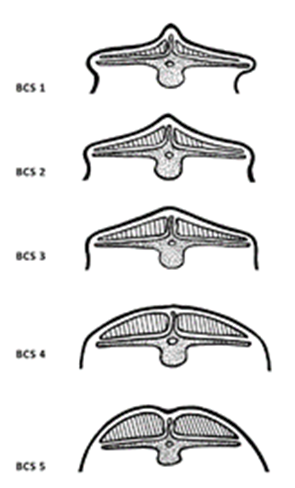Calving difficulty and stillbirth are challenges for the beef industry. Prevention and appropriate management will decrease mortalities for cows and calves, which will increase profit revenues and improve animal welfare.
Several scientific studies show that there is a direct link between the BCS of the suckler cow and the risk of dystocia. For example, cows with an increased BCS (above optimum) are more likely to give birth to calves with an increased birth weight that can lead to birthing difficulties. Furthermore, fat deposits can narrow the birth canal and lead to difficulties. Emaciated cows give birth to weak calves or even do not survive calving. Therefore, the regular monitoring of the body condition and an appropriate feeding can help to reduce dystocia in cow-calf herds.
Body condition scoring (BCS) is a well-known procedure that can be easily implemented. It means evaluating meatiness and fat deposits on the protruding bones. The fat layer must be assessed on the edge of the lumbar bones, the head of the tail and the ribs. The rating on a scale from 0 (emaciated) to 5 (excess fat) provides information about the feeding status of the cow.
 www.beefproducer.ca (Body condition scoring, 2019)
www.beefproducer.ca (Body condition scoring, 2019)
Applying the scoring system requires however some practice and experience. Especially when using the scoring system for the first time, it should be implemented by at least two different assessors and the results should be compared. Then on a day-to-day basis, it is preferable that always the same person assesses the body condition of a cow. From time to time it is also advisable to have an external person assesses the herd to avoid an "operational blindness".

(Photos by Karin von Deylen 2020)
The last third of pregnancy is not sufficient to correct feeding-related problems; the animals should be constantly monitored and the feeding adjusted accordingly.
(For more information about body condition scoring go to: https://www.teagasc.ie/media/website/animals/beef/feeding-the-suckler-cow.pdf)
This method has a positive impact across Socio-economic Resilience and Production Efficiency & Meat Quality:
- Socio-economic Resilience – Less dystocia problems allow a reduction of production costs
- Production Efficiency & Meat Quality – Cow’s conception rate is better after a smooth birth than after experiencing dystocia, and calving without assistance requires less labour time.